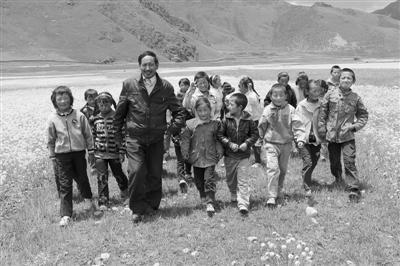By Zhu Shan Source:China Tibet News 2015-09-18

Photo shows that students take part in the practical activities leaded by their teachers. [photo/ Lu Mingwen]
According to the data from the Education Department of Tibet Autonomous Region, by the end of 2014, the enrollment rate of primary school students, junior middle school students, senior middle school students is 99.64 percent, 98.91 percent and 73.37 percent respectively. Tibet had 608,506 school students covering all grades. Besides, there are 1.82 million people getting rid of illiteracy, the illiteracy rate among young and middle-aged people has decreased to 0.57 percent, and the average length of education has reached 8.6 years.
“ When I was a child in 1983, I lived in Shigatse. Everyday, I did nothing except looking after crows. Sometimes, laying on the grass, I wondered did any other villages like us? One day, I went to Lhasa, the capital city of southwest China’s Tibet Autonomous Region, and was amazed at this prosperous city. In Lhasa, it also was the first time for me to watch TV. This trip changed my life. My relatives living in Lhasa told my parents to let me go to school instead of only feeding cows.” recalled by Tseten, a vice professor of one school in Tibet, “ My parents are illiteracy and living by feeding cows. My relatives told them that children from herdsmen’ s families enjoy free education. If their children study hard, their children will have opportunities to live in Lhasa and be state cadres. My parents still thought I should look after cows instead of going to school. Luckily, I was 11 years old at that time and managed to go to school when I was 12 years old. My classmates are 12 years old, some even 17 years old. They all were persuaded to go to school by their literate relatives and teachers.”
Now, the daughter of Tseten, 4 years old, is studying in inland Tibetan classes. “ Nowadays, children living in good conditions knows a lot. They even planed their own lives. My daughter’s dream is to go to Beijing University and then get further study at abroad.” said by Tseten.
Before the peaceful liberation of Tibet, the educated were mostly aristocrats, while serfs and slaves, accounting for 95 percent of the total population of Tibet, had no right to education at all. After the peaceful liberation, in order to let the Tibetan enjoy better education, with a large investment, the central government help to build the modern schools and implement the modern educational system. Over the five decades, 85.8 bln yuan have been put into Tibet’s education.
In recent years, students from farmers and herdsmen’ s families were supported by the regional government and the Educational Department to go to school. Besides, the problem of lacking kindergartens also were solved. In 2013, with an investment of 397 million yuan, 275 kindergartens were built, occupying an area of 146,000 square meters. In 2014, another 209 kindergartens were built in Tibet, with an enrollment rate of 59.11 percent among pre-school children. In 2015, 237 bilingual pre-schools in agricultural and pastoral area and kindergartens in urban area are planed to be built in Tibet.
13.5 billion yuan were put into Tibet’s education in 2014, among which there were 3.3 billion yuan invested in the building of schools and kindergartens in remote agricultural and pastoral areas.
Copyright © Xizang Daily & China Xizang News All rights reserved
Reproduction in whole or in part without permissions prohibited
Index Code: 藏 ICP 备 05000021 号
Producer: Xizang Daily International Communication Center